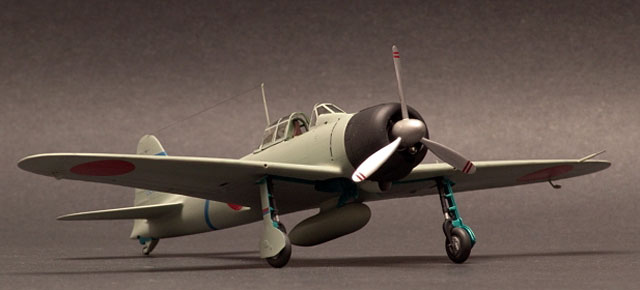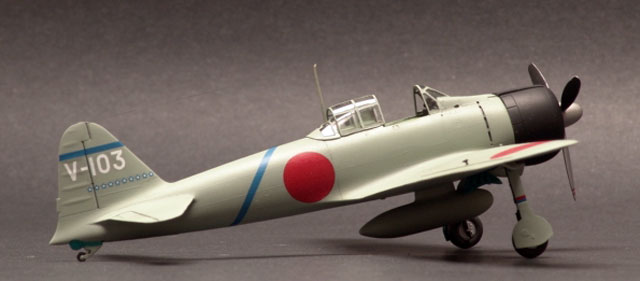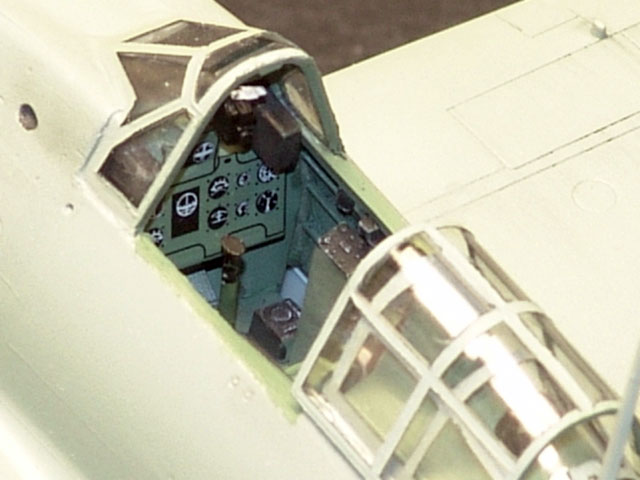|
Tamiya's 1/48 scale
A6M2 Zero Type 21
by Jeffrey Brundt
|
 |
|
Mitsubishi A6M2 Zero
Type 21 |

Tamiya's
1/48 scale A6M2 Zero Type 21 is available online from Squadron.com
This early war version of the most famous of all
Japanese fighters was, without doubt, the best fighter in the Pacific
when the United States entered the war, in 1941. Although U.S.
intelligence had been receiving reports about the capability of the Zero
for 18 months prior to Pearl Harbor, these were either ignored or
dismissed outright as incredible. Hence when the war with Japan began,
U.S. air forces were caught completely by surprise.

Nothing in the U.S. aircraft arsenal could match
it, although the P-40 was more maneuverable in a run-for-your-life dive.
It would take the arrival of faster, more heavily armed American
fighters, along with a change of tactics away from the classic turning
dogfight, before the Zero's weaknesses would be revealed and exploited.
What's in the Box
The Zero, next to the P-51 and Bf-109, is probably
the most modeled WWII fighter. The Tamiya kit of the early war Zeke was
considered state-of-the-art when it was released over 25 years ago. By
todayís standards itís just okay. Cockpit detail is passable and there
are a mix of very fine raised and engraved panel lines. The wheel wells
are molded in and detailed plus you get a choice of either open or
closed canopy clear parts. The engine is just a half molding so
displaying it with the cowl removed or open requires some aftermarket
resin. Flaps are molded in place so donít expect Hasegawa finery here.
Despite their age these molds have really stood up to the test of time.
There is no flash. The only problem I could see was the lower wing
(which is one piece) was a bit warped. The decals are typical Tamiya and
seem thick but after application that thickness appears to go away.
Construction
Cockpit assembly is straight forward. I gave
everything a coat of Japanese interior green first. Then applied a black
enamel wash and painted the various side consoles and details balck.
There is no molded-in instrument panel detail. Itís blank and flat.
There is a decal to use which is passable.

Some may prefer to replace the cockpit with an
Aires or True Detail resin set but I was building this strictly OOB and
trying to keep the price down (hey, I got the kit for $11 at the LHS).
The fuse seams require a bit of carefull sanding and filling to preserve
the raised panel line detail. However the wing to fuse joint is perfect.
The seam between the front windshield and the fuse is a bit Ďoffí so I
used some thinned putty here. The kit does go together very quickly and
I admit I spent more time sanding the mentioned seams then anything.
Once I was satisfied with everything then I masked
off the windscreen and cockpit and gave the plane a light coat of
primer. Since these were naval birds the paint scheme was relatively
easy. I sprayed Tamiya IJN grey acrylic over the airframe and PollyScale
black acrylic for the cowl.
Once those colors were dry I masked off the gear
bays and inside gear doors for Gunze aotake green. The prop and spinner
were sprayed Floquil old silver. Clear gloss followed in preparation for
decaling.
One thing is for sure, Tamiya gives you plenty of
options on the decal sheet. There are markings for 5 different Zeros. I
chose the markings for Japanese ace Saburo Sakai around the early 1942
timeframe. The decals went on with no trouble but I did need to bring
out the big guns for getting them to snuggle down; I used Waltherís
SolvaSet. Once the decals were dry I applied a panel line wash with
thinned, black enamel. I didnít weather the bird that much.

Early war Zeros always look very clean and well
kept compared to the late war variants. A clear, satin coat of
PollyScale was applied and it was time to install the landing gear,
wheels, antenna and antenna wire. I opted for the open canopy since I
had installed a set of posable CE seatbelts and wanted to show them off.
So there you have it - a nice rendition of an early
war Zero at an affordable price. There are other, more detailed and
expensive Zekes out there but the Tamiya kit represents a good value for
the modeling dollar and builds into a fine aircraft.
Click
the thumbnails below to view larger images:
Model, Images and Text Copyright ©
2005 by Jeffrey J. Brundt
Page Created 21 April, 2005
Last Updated
21 April, 2005
Back to
HyperScale Main Page |
Home
| What's New |
Features |
Gallery |
Reviews |
Reference |
Forum |
Search